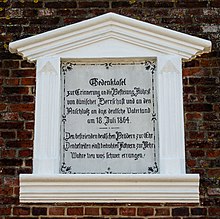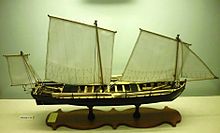Conquest of the North Frisian Islands
|
|
This article or section was due to content flaws on the quality assurance side of the editorial history entered. This is done in order to bring the quality of the articles in the field of history to an acceptable level. Articles that cannot be significantly improved are deleted. Please help fix the shortcomings in this article and please join the discussion ! |
| date | July 12, 1864 to July 20, 1864 |
|---|---|
| place | North Frisian Islands |
| output | Occupation of the North Frisian Islands by Austria |
| Parties to the conflict | |
|---|---|
| Commander | |
| Troop strength | |
| 250 | |
| losses | |
|
(indirectly) two hunters because of a knife fight |
nine officers and 185 sailors in captivity |
Missunde - Königshügel - Danewerk - Schlei - Oeversee - Jutland - Vejle - Jasmund - Düppeler Schanzen - Fredericia - Helgoland - Alsen - Lundby - North Frisian Islands
The conquest of the North Frisian Islands in July 1864 was the last military operation of the German-Danish War between Denmark on the one hand and Prussia and Austria-Hungary on the other around the Danish duchies of Schleswig and Holstein . It ended with the occupation of the North Frisian Islands by Austrian troops.
prehistory
After Prussia and Austria had already largely brought the duchies of Schleswig and Holstein under their control as a result of the Prussian victory at Düppeln , an armistice came into force on May 12, 1864. After the failure of peace negotiations at the London Conference called for this purpose, Prussia and Austria agreed in the Karlovy Vary Agreement to continue the fighting. With the end of the ceasefire, the conquest of the remaining parts of the duchies began, including the North Frisian islands. Amrum , South Rømø , North Sylt and West Föhr did not belong to the Duchy of Schleswig , but were part of Denmark. Parts of the population were also Danish.
On the Danish side, Lieutenant Captain Otto Christian Hammer , who was also customs , beacon and buoyage inspector from Wyk, was charged with defending the North Frisian Islands. His base of operations was Wyk auf Föhr . In order to suppress a popular uprising, Hammer resorted to draconian measures. He also took action against riots on Sylt. To finance this guerrilla war, he had all customs, tax and postal accounts confiscated. On March 3, he arrested four alleged collaborators of the other side, including Andreas Andersen, in the town of Keitum, which belongs to Schleswig . On June 13, he had the whole place surrounded and eight rebels arrested. Among them was the local poet Christian Peter Hansen , who described Hammers behavior as a “tyrannical regiment” and him as a “Vikings tyrannizing country and people” and who disseminated his personal views in his later writings.
The west coast of Schleswig-Holstein fell into Austria's operational area and Rear Admiral Bernhard von Wüllerstorf-Urbair decided to conquer the islands. He was supported by Prussian units. Due to bad weather, the Austro-Prussian flotilla left Cuxhaven for the operational area two days later than planned .
Occupation of the islands
The forces of both sides
Hammer's flotilla consisted of
- the paddle steamer Lymfjord ,
- the screw steamboat Augusta ,
- 8 cannon dinghies with 17 men each and one gun,
- 12 customs cutters and
- ten other coastal vessels.
The opponent had
- the ironclad SMS Juan d'Austria (Austria),
- the ship of the line Kaiser (Austria),
- the steamship Elisabeth (Austria),
- the gunboat SMS Basilisk (Prussia),
- the gunboat SMS Blitz (Prussia),
- the gunboat Seehund (Austria),
- the gunboat Wall (Austria).
Since only ships with shallow drafts could be used in parts of the North Frisian Wadden Sea , the thick ships were mostly only indirectly involved in the operation. The four gunboats were under the command of the Austrian frigate captain Karl Kronowetter . Then there were the 5th and. 6th company of the Kuk Feldjäger Battalion No. 9 from Styria under the command of Lieutenant Colonel Franz von Schidlach .
Oland and Sylt
On July 6th, Oland was taken over by General Staff Captain Wiesner with nine hunters. The small troop had waded over from the mainland. Since the island had no military value, they left after two hours. The attempted landing on Sylt on July 12th by military police with oar cannon dinghies was thwarted by the shelling of the Danish and perhaps also the Austrian gunboats. Because the Austrian Navy had not been informed that the Austrian Army should intervene. Andreas Andersen then offered three Austrian army officers to lead them from Højer Sogn to the Austrian fleet command in front of List . The men went from Jerpstedt through the dry mudflats and reached the ship fleet to within a third of a mile when the tide began. In danger of her life, she took the gunboat “Seehund” on board at the last minute. There the men sent an order from the Ministry from Vienna that the Austrian army should help liberate Sylt and Föhr. So the field hunters tried their luck again on July 13th. When they were fired at again, they simply pulled the small rowboats onto a sandbank and waited for the tide to ebb, which meant that the gunboats had to pull away. So finally 200 Austrian military police arrived on the island. The 5th Company crossed from Hoyer and Keitum and the 6th Company from Klanxbüll to Morsum ; they were welcomed as liberators by the German-minded population. In front of Keitum they had built a gate of honor with the inscription: "German brothers, are welcome!" In Morsum the soldiers were given a festive meal and the four commanders made honorary citizens.
Rømø, Föhr and Amrum and blockade of the North Frisian Islands
On July 14th, the island of Rømø was occupied by Captain Wendt from Ballum. On July 16 they occupied List and crossed over to Föhr and Amrum in two gunboats .
On July 17, the Allies blocked the access routes from the North Frisian Wadden Sea to the North Sea by two Austrian units under Rear Admiral Bernhard von Wüllerstorf-Urbair and Vice Admiral Wilhelm von Tegetthoff .
Föhr, Langeneß and Gröde
On July 18th at six in the morning the bombardment of the Danish flotilla began in the harbor of Wyk auf Föhr and the occupation of Langeness and Gröde .
Three hours earlier, however, the Prussian Lieutenant Colonel Gustav von Stiehle and the Danish Colonel Heinrich von Kauffmann (Chief of the General Staff) had signed the armistice between Prussia, Austria and Denmark in Christiansfeld , which came into force on July 20, 1864 at twelve o'clock. Hammer learned of the armistice earlier than the Allied forces on site and sent an officer to the Austrian commander of SMS Elisabeth , who informed him that an armistice had been signed. The Allies then stopped the fire.
Surrender of the Danish defenders
When the Allies learned that the armistice would not come into force until July 20, fighting resumed on July 19. As a result, seven officers, two officials and 185 men of the Danish flotilla surrendered to the Allied forces on July 19 in view of the hopeless situation. Hammer had used the night to take off into the Wadden Sea with his gunboat Liimfoerd . He was not caught by the Prussian gunboat Blitz until the evening , after which he painted the flag and handed over his sword with his first officer at 7:30 p.m., a few hours before the armistice came into force. This was forwarded to Prince Adalbert by the commander of the Blitz , Lieutenant Captain Archibald MacLean .
consequences
The captured Danish ships were initially brought to Cuxhaven and remained in Prussian possession. From July 20th to 22nd, Hammer was released to his family in Wyk. When he left the village, he was protected from attacks by the Austrian hunters. Then he was transported into captivity via Husum and Rendsburg to Altona.
Due to the outcome of the war and the resulting Peace of Vienna , the islands initially became part of the Austro-Prussian condominium in Schleswig-Holstein . The Austrian troops stayed on the islands for three months. Therefore, on August 18, 1864, the 34th birthday of Emperor Franz Josef as co-sovereign was solemnly celebrated on Föhr . The Wyker Fleckenkollegium sent him a congratulatory telegram on this occasion:
"The liberated Föhr sends [...] His Majesty to the Emperor of Austria his warmest congratulations and deepest thanks."
With the Gastein Convention in the following year, the condominium was dissolved and the islands came under Prussian sole control. In 1866 they were annexed by Prussia with the other areas of the duchies of Schleswig and Holstein. From the islands only Rømø came back to Denmark in 1920 with the referendum in Schleswig .
Remembrance and commemoration
On the island of Föhr in Wyk there is still a tombstone with the epitaph :

F. Tausendschön
and
A. Medwescheg
from Styria
from 9th. KK Feldjäger
Bataillon
died in Lazareth
zu Wyck auf Föhr
1864.
Liberation day
the 18th. July 1864
The cause of death of both soldiers is unclear. However, it is said that they were wounded because of a love affair and that they died in the hospital (Redlefsens Hotel) in Föhr on July 30th and August 7th. On the anniversary of the liberation, on July 18, 1865, the gravestone was placed with great sympathy from the population. In 2005 it was restored again.
Web links
Individual evidence
- ↑ Sylter Rundschau October 21, 2013
- ^ Power of attorney from the Commander in Chief of the Allied Army Friedrich Karl Prince of Prussia for Lieutenant Colonel von Stiehle to conclude an armistice requested by Denmark in the German Digital Library , accessed on October 16, 2015.
- ^ Document of the Christiansfeld armistice between Prussia, Austria and Denmark in the German Digital Library , accessed on October 12, 2015.
- ↑ SHZ of November 27, 2016
literature
- Frank Jung: 1864. The war for Schleswig-Holstein. Ellert & Richter Verlag for Schleswig-Holsteinischer Zeitungsverlag , Hamburg 2014, ISBN 978-3-8319-0566-9 .
- Oliver Bruhns: Schleswig city stories. In: Reimer Witt, Oliver Bruhns: 1200 years of Schleswig. ed. from the Lions Club Schleswig, 2006.

